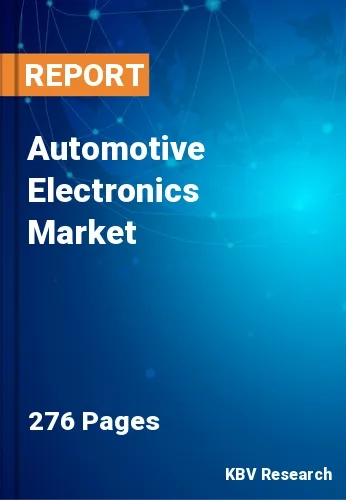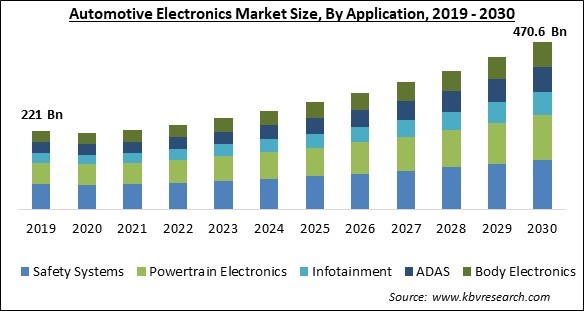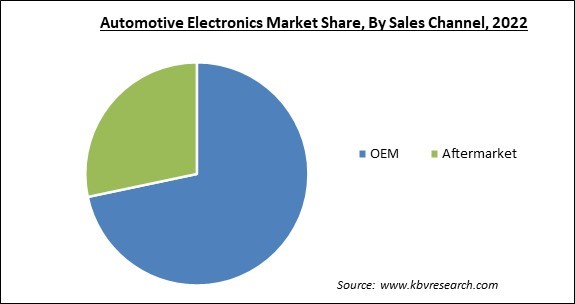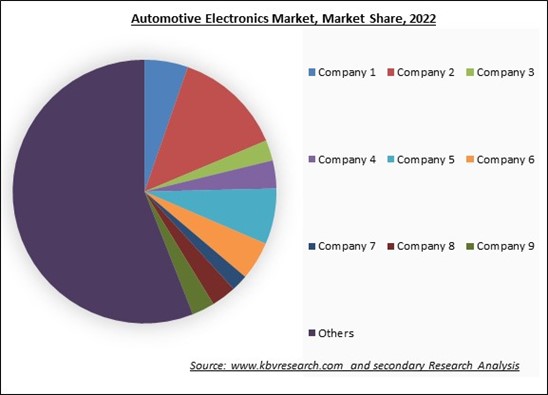
The Global Automotive Electronics Market size is expected to reach $470.6 billion by 2030, rising at a market growth of 9.1% CAGR during the forecast period.
Sensors utilized to detect physical factors, the proximity and positioning of a vehicle, chemical qualities, and process variables are included in the sensors segment. Therefore, the sensors segment will capture 1/5th share of the market by 2030. Governmental initiatives promoting passenger safety and security in a number of countries are anticipated to stimulate revenue expansion. Due to the fact that they monitor variables such as temperature, speed, and tire pressure & condition and take preventative action in the event of peril, these devices have become an integral part of automobiles. Some of the factors impacting the market are increasing demand for electric vehicles, increasing prevalence of vehicles with automated driving, and high cost of development.

The global adoption of electric vehicles (EVs) is increasing rapidly and is expected to continue to rise. According to the International Energy Agency (IEA), over 2.1 million electric vehicles were sold in 2019, accounting for approximately 2.6% of global vehicle sales. Additionally, they accounted for roughly one percent of the worldwide car stock in 2019, a 40% increase year-over-year compared to 2018. Technological advances make the accelerated electrification of lorries, buses, and other vehicles possible, particularly in the battery technology sector. Furthermore, due to its ability to perceive its environment, an autonomous or unmanned vehicle can operate and perform important functions without human intervention. The adoption of autonomous vehicles is augmented by factors like the enhancement of safety, the reduction of traffic congestion, the expansion of connected infrastructure, and the transition from ownership to mobility-as-a-service (MaaS). Thus, the market may experience significant development due to surge in demand for EVs has a significant effect on the market and the growing adoption of sensors and other equipment-equipped automated vehicles.
However, implementing sophisticated electronic technologies and systems in vehicles is expensive, which is one of the primary factors restraining the market. Incorporating advanced electronic systems and technologies into vehicles can substantially increase the vehicle's total cost. This includes the costs associated with components, software development, testing, and integration. Particularly in price-sensitive markets, the higher cost of vehicle electronics may make vehicles more costly for consumers, reducing their accessibility and adoption. This hinders the market's expansion as a whole. These factors are anticipated to hinder the growth of the market.
Based on the sales channel, the market is segmented into OEM and aftermarket. In 2022, the aftermarket segment covered a considerable revenue share in the market. The term "aftermarket" refers to the secondary market within the automotive industry responsible for the production, distribution, retailing, and installation of all vehicles electrical parts and accessories after the sale of the vehicle to the consumer by the original equipment manufacturer (OEM).

Based on application, the market is segmented into ADAS, infotainment, safety systems, and powertrain electronics. In 2022, the safety systems segment dominated the market with the maximum share. Airbags, keyless entry systems, electronic brake distribution, electric power steering, tire pressure monitoring systems, electronic stability control, and suspension control are examples of safety system components. Rising consumer awareness of technological advancements impacting automobile safety equipment is expected to be a major factor in the market growth.

The leading players in the market are competing with diverse innovative offerings to remain competitive in the market. The above illustration shows the percentage of revenue shared by some of the leading companies in the market. The leading players of the market are adopting various strategies in order to cater demand coming from the different industries. The key developmental strategies in the market are Acquisitions, and Partnerships & Collaborations.
Based on components, the market is segmented into electronic control units, sensors, current-carrying devices, among others. The current-carrying devices segment held the highest revenue share in the market. This results from the high cost of components, such as connectors and wiring harnesses. Additionally, government programs like Make in India and factors like lower labor costs and higher disposable income in developing economies have increased the manufacturing of passenger automobiles and light commercial vehicles.
| Report Attribute | Details |
|---|---|
| Market size value in 2022 | USD 237.7 Billion |
| Market size forecast in 2030 | USD 470.6 Billion |
| Base Year | 2022 |
| Historical Period | 2019 to 2021 |
| Forecast Period | 2023 to 2030 |
| Revenue Growth Rate | CAGR of 9.1% from 2023 to 2030 |
| Number of Pages | 276 |
| Number of Table | 370 |
| Report coverage | Market Trends, Revenue Estimation and Forecast, Segmentation Analysis, Regional and Country Breakdown, Market Share Analysis, Companies Strategic Developments, Company Profiling |
| Segments covered | Component, Sales Channel, Application, Region |
| Country scope | US, Canada, Mexico, Germany, UK, France, Russia, Spain, Italy, China, Japan, India, South Korea, Singapore, Malaysia, Brazil, Argentina, UAE, Saudi Arabia, South Africa, Nigeria |
| Growth Drivers |
|
| Restraints |
|
Region wise, the market is analyzed across North America, Europe, Asia-Pacific, and LAMEA. In 2022, the Asia Pacific region witnessed the largest revenue share in the market. South Korea, Taiwan, Malaysia, and Thailand have considerably contributed to the market's growth due to their thriving electronic component manufacturing industries. China and Japan satisfy the vast majority of automotive electronics demand in Asia-Pacific. Yet, the limited number of automotive electronics OEMs creates an ideal investment prospect for regional suppliers to take advantage of local demand, making the rest of the Asia-Pacific region attractive to capitalists.
Free Valuable Insights: Global Automotive Electronics Market size to reach USD 470.6 Billion by 2030
The market research report covers the analysis of key stake holders of the market. Key companies profiled in the report include Continental AG, Robert Bosch GmbH, Sony Corporation, Aptiv PLC, Hyundai Mobis Co., Ltd. (Hyundai Motor), ZF Friedrichshafen AG, Infineon Technologies AG, Magna International, Inc., Aisin Corporation (Toyota Motor Corporation) and Koninklijke Philips N.V.
By Application
By Sales Channel
By Component
By Geography
This Market size is expected to reach $470.6 billion by 2030.
Increasing Demand for Electric Vehicles are driving the Market in coming years, however, High Cost of Development restraints the growth of the Market.
Continental AG, Robert Bosch GmbH, Sony Corporation, Aptiv PLC, Hyundai Mobis Co., Ltd. (Hyundai Motor), ZF Friedrichshafen AG, Infineon Technologies AG, Magna International, Inc., Aisin Corporation (Toyota Motor Corporation) and Koninklijke Philips N.V.
The OEM segment is leading the Market by Sales Channel in 2022; thereby, achieving a market value of $319.3 billion by 2030.
The Asia Pacific region dominated the Market by Region in 2022 and would continue to be a dominant market till 2030; thereby, achieving a market value of $187.1 billion by 2030.
Our team of dedicated experts can provide you with attractive expansion opportunities for your business.
